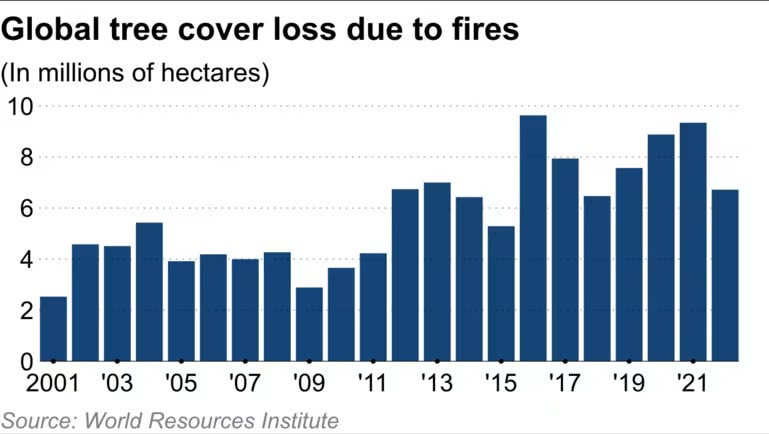Wildfires caused by climate change continue to burn forests worldwide, discharging large amounts of carbon dioxide and fueling global warming. Last year’s large forest fires in Canada produced three times more CO2 than the amount the country generally emits from its annual economic activity.
“Temperatures during 2023 likely exceed those of any period in at least the last 100,000 years,” said Samantha Burgess, deputy head of the European Union’s Copernicus Climate Change Service, warning against the growing risk of the greenhouse effect.
Wildfires increased as a result of warmer and drier conditions. The damage was particularly severe in Canada. “Year after year, with climate change, we’re seeing more and more intense wildfires,” Canadian Prime Minister Justin Trudeau tweeted last June, “and they’re starting to happen in places where they don’t normally.”
In Canada, wildfires began to increase in April, prompting the western province of Alberta to declare a state of emergency the following month. A number of large forest blazes occurred in Quebec in June, forcing many residents to flee their homes. The western province of British Columbia saw the largest wildfire in its history.
More than 180,000 square kilometers of forest land in Canada—an area nearly half the size of Japan—was consumed in the blazes, according to the Canadian Interagency Forest Fire Center. The smoke drifted across the border into the US, causing serious air pollution in New York, Chicago, and Detroit.

The megafires in Canada produced 1.7 billion metric tons of CO2 in 2023, roughly three times the amount Canadians emit annually through economic activities, according to an estimate based on data from the EU’s Copernicus Atmosphere Monitoring Service.
Forests are fast disappearing in other parts of the world as well. According to the US-based World Resources Institute, an average of 8.3 million hectares of forests went up in flames per year from 2020 to 2022, approximately double the average from 2001 to 2003 and more than double the annual loss caused by felling and other activities in Brazil, where much of the Amazon rainforest, called the lungs of the Earth, is located. The institute mostly blames the loss of forest land on climate change.
“We see that climate change is making fire more extreme,” said Marta Arbinolo, a policy analyst at the Organization for Economic Co-operation and Development. “At the same time, we see that more extreme fires contribute to climate change.”
Global warming causes heat waves and dry spells, which make it easier for wildfires to start from lightning or campers’ careless handling of fire. The wildfires produce large amounts of CO2, further worsening the cycle of global warming.
The world may have entered a negative spiral. According to a 2022 report by the United Nations Environment Programme (UNEP) and the Norwegian foundation GRID-Arendal, the occurrence of large forest fires is forecast to increase by up to 14% from the 2010–2020 level by 2030, and 33% by 2050. There could be “a global increase of extreme fires even in areas previously unaffected,” UNEP warned.

The EU’s core bodies reached a broad agreement last November on a set of measures to prevent wildfires, including one to make peat lands wet again. Forest fires are often caused by the drying of peat land, a type of wetland made up of decaying or carbonized plants. The European Commission, the EU’s executive arm, is considering legislating the group monitoring of forests.
It is past time for the world to wake up to the possible consequences of global warming and act to sever the adverse feedback loop between climate change and extreme wildfires.
This article first appeared on Nikkei Asia. It has been republished here as part of 36Kr’s ongoing partnership with Nikkei.
